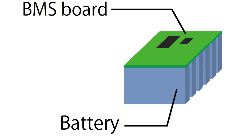The inverter is the main device to interact with the photovoltaic system, through this equipment you can manage many functions.
An inverter converts the DC voltage generated by photovoltaic cell to an AC voltage to supply “load”, load refers to the power consumption of the device(s) that are being used in the system such as washing machines and vacuum cleaners.
Ordinary Inverter converts the DC voltage generated by photovoltaic cell to an AC voltage to supply “load”.
Hybrid inverters manage both the photovoltaic production and the battery
Retrofit inverters deal with the management of energy storage only.
The inverter power range can be checked in Ucanpower product list
The Battery Management System (not to be confused with building management system)

BMS performs different functions:
when any cell of the battery pack exceeds the initial balancing voltage, the BMS redistributes the excess charge between the various cells (active balancing) or using special resistors (passive balancing).
Battery state estimation: The state of charge (SOC) and health status (SOH) of the battery is estimated based on voltage and current values.
Detection of any malfunctions: voltage measurement to check for overloads in charge or discharge; resistance measurement to detect faults in connections; temperature monitoring; Real-time diagnosis of battery pack isolation loss.
These functions of the BMS allow you to extend the life of the battery, so it is important to be able to verify its correct functioning.
ESS (Energy Storage System) is the ability to communicate with other devices and allows you to manage and optimize the energy produced with home automation systems for controlling loads, heat pumps, vehicle charging systems and more.
During the day, it stores solar energy in the battery for later use when the sun goes down.
It allows you to move the power in time, charge from the solar power system, supports the power grid and feeds electricity back into the grid.
When an ESS system can produce more electricity than it can use and store, it can sell the surplus to the grid and when it has insufficient power or power, it automatically buys it from the grid.
The ESS is used to combine, for example, the use (e.g. 40% of the capacity) of the battery for self-consumption and keep the remaining (60%) available as a backup in the event of a failure of the power grid.
The ESS is used to optimize self-consumption:
When there is more PV energy than is needed to run the loads, excess PV energy is stored in the battery. The stored energy is then used to power the loads at times when there is a shortage of photovoltaic energy.
The percentage of battery capacity that can be used for self-consumption is configurable. When it is extremely rare for a mains fault to occur, it can be configured to 100 %. In locations where network failures are frequent, or even daily, you can choose to use only 20 % of the battery capacity and retain 80 % to cope with the next network failure.
is a domestic photovoltaic system with storage that integrates the inverter, charger and ESS in a single enclosure and ready for installation.
If designed with IP65 requirements, it can be mounted inside or outside the home, resistant to conditions more challenging weather
